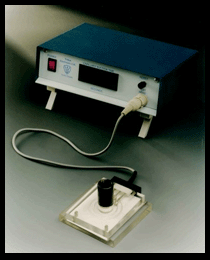| MAIN MENU
CATALOG INDEX For more info: 경기도 안양시 동안구 호계동 555-9
Fax :
|
304M CST Meter(데스크탑형) 304B CST Meter(휴대형) Description The electronics has been improved and the mechanical counter replaced by a LCD. The unit has been designed and tested to comply with European and USA EMC standards. The mains input supply can be set for either European or USA standards. This unit is now the basic laboratory CST test equipment. General Specification
Capillary Suction Time은 1970년대 이후로 슬러지 여과및 데이터처리를 신속하게처리할수
있는 방법으로 이용되어왔습니다.
표준 여과지에 의해 발생된 모세관흡인압 (capillary suction pressure)은 슬러지로부터 물을빨아들이며
모세관흡인압에 의해서 발생된 힘은 깔때기내의 hydrostatic head에서 발생된 힘보다 훨씬커서
각각의 테스트 완료에는 수 분이 걸릴수 있습니다. |
 |
2-6.1.2 Conditioning Tests. Optimizing chemical dosages is not only important to
the dryness of the cake, but it also affects the solids capture rate and solids disposal
costs. Several types of tests can evaluate the effectiveness of a single conditioning
chemical or group of conditioning chemicals. Standard test procedures include jar tests,
CST tests, Buchner funnel tests, and pilot-scale and on-line testing. Although chemical
dosages should be initially evaluated, they should also be reevaluated periodically
because of changes in sludge characteristics.
2-6.2
Test Procedures. Test procedures that can be used for both basic filterability
testing or conditioning testing include jar tests, CST tests, specific resistivity tests, and
pilot and on-line tests.
2-6.2.1 ?Jar Testing. Jar testing, the simplest type of conditioning testing, is often
used for the preliminary evaluation of the type and estimated quantity of conditioners
required. Jar testing involves the visually observing the size of sludge floc produced
when various types and quantities of different types or combinations of conditioning
chemicals are mixed with samples. This type of testing can be used to screen or elimi-
nate different types of chemical conditioners and determine the effects of different dos-
ages of a specific conditioner. A description of the jar testing procedure is outlined in
Design Manual--Dewatering Municipal Wastewater Sludge (EPA 1987).
2-6.2.2 Capillary Suction Time Testing. The capillary suction time (CST) test
involves measuring the time to move a volume of filtrate over a specified distance as a
result of the capillary suction pressure of dry filter paper. The CST test provides infor-
mation regarding the ease of separating the water portion from the solids portion of
sludge. This type of testing is most effectively used during the selection of the optimum
conditioner dosages during on-line tests. The CST is typically defined in units of time
(seconds). For, example, the typical range of CST for unconditioned organic wastewater
sludge is 100 to 200 seconds (EPA 1987). In general, to dewater this type of sludge in a
filter press, a CST of 10 seconds or less is required. A detailed theoretical description of
this method and its procedures are presented in Design Manual--Dewatering Municipal
Wastewater Sludge (EPA 1987).
2-6.2.3 Specific Resistance Testing. Specific resistance testing has been widely
used and investigated as a way to evaluate the effectiveness of filterability. Specific
resistance is typically defined in units of tetrameters (1012 m) per kilograms (Tm/kg).
The specific resistance for raw wastewater typically ranges from 10 to 100 Tm/kg (1.5 x
1013 to 15 x 1013 ft/lb) (EPA 1987). Generally, the specific resistance can be adjusted by
a factor of 100 to 1000 (e.g., 0.1 to 1.0 Tm/kg [1.5 x 1011 to 15 x 1011 ft/lb]) with proper
conditioning. A lower specific resistance indicates increased dewaterability. This testing
can be done by calculating the specific resistance from Buchner funnel testing or by
measuring the specific resistance directly with specific resistance test meters.
The Buchner funnel test is a method commonly used for predicting the spe-
cific resistance of sludge. A detailed theoretical description of this testing and its pro-
cedures are provided in Design Manual--Dewatering Municipal Wastewater Sludge
(EPA 1987).
2-64
|